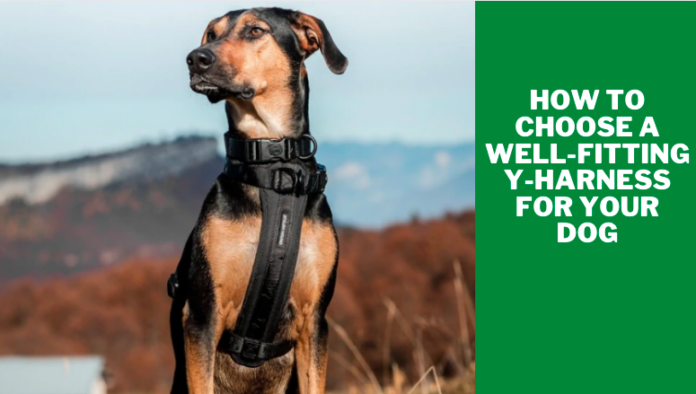Last Updated on February 17, 2024 by Fumipets
Guide to Canine Comfort: Choosing the Perfect Y-Harness for Your Dog
Selecting the right harness for your furry companion is more than just a practical necessity; it’s an essential element of their comfort, safety, and overall well-being. Among the myriad of harness styles available, the Y-harness stands out as a popular choice for its ergonomic design and effective control.
In this guide, we unravel the nuances of choosing a well-fitting Y-harness for your dog, ensuring not only a secure restraint but also a snug and comfortable fit for your canine companion’s every adventure.
Choosing the Perfect Y-Harness for Your Dog
Just like clothes, not all dog harnesses fit everyone perfectly. In fact, a lot of people make the mistake of just guessing when it comes to picking out a harness for their pup. This can lead to discomfort and even injuries down the road. So, if you’re in the market for a new Y-harness for your furry friend, read on! We’ll show you how to find the perfect one for your pup’s body type.
Why it’s important to fit the Y-harness correctly
Y-harnesses are more difficult to fit than you may think. Like office-desk-and-chair configurations, Y-harnesses should be fit in accordance with your dog’s ergonomic requirements.
If you don’t do this, your dog runs the risk of injuries just as they do when pulling away from the leash in only a collar, sans harness. Just as we want to avoid a collapsed trachea, we want a find a harness that won’t compromise your dog’s posture or chafe beneath the front legs.
Things to look out for when fitting a Y-harness
That being said, finding something that will fit to a perfect tee will be difficult. However, so long as your harness is ticking the below criteria, you should be good to go:

Image: Stylish Hound
Shoulders
Shoulders can be difficult to locate on a dog, but here’s a tip: those bones located either side of their chest? Those are the shoulder joints. These may be particularly difficult to pinpoint on flooffier friends, but all dogs have them! When fitting a Y-harness, the shoulder straps should sit above the shoulder.
Ensure to position the back section a cat’s whisker above the shoulders, too. This will allow your dog more comfortable neck movement. When your dog pulls on the lead, just make sure the neck straps are not covering the shoulder joints.
Chest bone
Have a feel of your dog’s chest. That spikey bone is the chest bone, and you want the Y-harness connection centred on there. Make sure it’s not sliding up the neck lest it puts undue pressure on the trachea.
‘Legpits’
Some people refer to these as dog armpits, completely ignoring the fact that dogs don’t have arms. Henceforth, for all intents and purposes, we will be referring to those pits beneath a dog’s front legs as ‘legpits’.
When fitting a Y-harness, consider the legpits to be ‘clear zones’. You’ll need to leave space behind the legs to allow for freer movement. That being said, don’t sit the harness so far back that it puts undue pressure on the soft tissue. In fact, when Y-harnesses are positioned this way, they can slide too far up as they’re being pulled forward.
Once you’ve fitted the harness, check that you can fit two or three fingers beneath the ‘legpit’ straps—or, if you have a larger dog, three to four fingers. This is a similar principle to fitting a collar or other type of dog harness.
Space between the front legs
Ensure the Y-harness is not spread wide between the two front legs. If it is, it will rub, chafe, and affect the way Doggy walks and runs. This affected stance is not only uncomfortable, but it can also burden the shoulder joints with excessive pressure. To check if the Y-harness is too wide, play fetch with and without the harness.
Compare the way your dog retrieves the ball, stick, or toy. When fitting the harness, you should also check that it isn’t chafing against the inside of the legs.
Final notes
It’s important to note that these guidelines are not hard and fast. A lot of it will come down to your dog’s temperament. For example, if your dog never pulls, then wider neck straps positioned over their shoulder joints will not be an issue, provided their legs can move freely.
If your dog does pull, just be sure to free the shoulders and to check the chest plate does not have too firm a grip.
Whilst some dogs will be okay with having straps close to the legpits, this will be an absolute no-no for dogs with sensitive skin. Let your dog, rather than this post, influence your final decision.

Image: Stylish Hound
Y-harnesses can be fiddly and difficult to fit, but once your dog finds their groove, they will be more comfortable and better protected from injury or choking. You will also have better control of your pooch.
For longer walks and reduced pulling, we recommend a well-fitted Y-harness for your dog.
Questions & Answers
What Makes a Y-Harness Different from Other Harness Styles?
Understanding the distinctive features of a Y-harness is crucial for pet owners looking to make an informed choice. The Y-shaped design distributes pressure evenly across the chest and shoulders, minimizing strain on the neck. This not only enhances control during walks but also provides added comfort, especially for dogs prone to respiratory issues or those with delicate tracheas.
How Do I Measure My Dog for a Y-Harness?
Achieving the perfect fit starts with accurate measurements. Begin by measuring your dog’s girth, around the widest part of their chest, just behind the front legs. Additionally, measure their neck circumference. With these measurements in hand, refer to the manufacturer’s sizing chart to ensure a snug fit without being too tight or too loose.
What Materials Should I Look for in a Quality Y-Harness?
Opting for a Y-harness crafted from durable and breathable materials is paramount. Common materials include nylon, polyester, or neoprene, known for their strength and resistance to wear. Ensure the hardware, such as buckles and D-rings, is sturdy and rust-resistant for longevity.
Are Y-Harnesses Suitable for All Dog Breeds and Sizes?
Y-harnesses come in various sizes to accommodate the diverse range of dog breeds and sizes. Whether you have a petite Chihuahua or a robust Labrador, manufacturers typically offer a sizing range. It’s essential to choose the appropriate size based on your dog’s measurements and weight to ensure optimal comfort and functionality.
What Features Should I Prioritize in a Y-Harness for Special Circumstances?
For dogs with specific needs or behaviors, additional features can enhance the utility of a Y-harness. Look for adjustable straps for a customizable fit, reflective elements for increased visibility during nighttime walks, and padded sections to prevent chafing. If your dog tends to pull, a Y-harness with front-clip attachments can provide better control and discourage pulling behavior.
Conclusion:
We hope you enjoyed this article…
Please feel free to share with us in the comments section below.


















